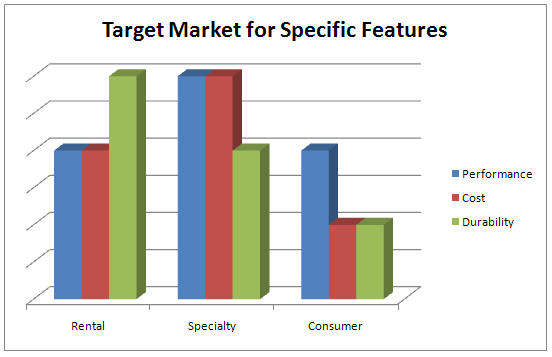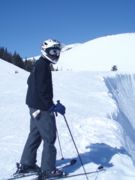Ski boot walking attachment redesign
From DDL Wiki
Acting upon the recommendations set forth in the previous report concerning problems related to walking in ski boots, this report presents further analysis of consumer needs as well as potential solutions. Skiers report near-universal annoyance at having to walk in their boots; some cited safety concerns. Most were satisfied with the trade-offs of carrying an attachment such as the WalkEZ if a significant stride benefit is to be had. The recommended solution is a boot attachment which employs translational and rotational freedoms to simulate normal foot movement despite a boot-locked ankle.
Contents |
Extended Summary
Market Research
Fourteen skiers were approached during the market research, in which eight were recreational skiers and six were the Carnegie Mellon Ski Team. We asked them their opinions on their concerns of walking in ski boots and where they wanted to see improvements in. Then, if they were aware of any existing solutions, we also requested additional information on what they felt of those solutions. Since most of the skiers that were approached had no clue of what the Walk-EZ Revolutions were, we had the skiers to try them on. With minor adjustments, they were all able to fit in the walking attachment; afterward, they gave us their feedbacks.
Survey
There was a general consensus on the uncomfortable nature of walking in ski boots. Most of the recreational skiers wanted to see more flexibility in the boots, specifically around the ankles.
“I just want to be able to bend at the ankles to get more mobility”
“... the main issue is the flexibility of the foot. I don’t know if this would be possible, but maybe some mechanisms that allow the sole to bend for walking so you can bend your toes a bit.”
“I would increase flexibility in the leg.”
Several of the serious skiers didn’t want any change on the boots that compromises the structural integrity of the boots and thus reducing the performance.
“In My experience there's not much you can do about it…there's always a trade off between comfort and performance.”
“The other option is something like Tele-boots, which would have the movable toe built-in. I worry about a solution like that compromising boot response and stiffness though when in a binding along with insulation/leakage at the joint.”
“I'd rather have a good experience skiing than a good experience walking around.”
The skiers agreed on the need of more flexibility around the ankles area when walking in ski boots, especially when walking up and down the stairs, but maintaining the rigidity to provide the support when skiing.
Existing Solutions
Several attempts on trying to solve this problem have been proposed in the past. All of them have been unsatisfactory or create more problems than they solve. The three most common solutions to this issue are unbuckling the clips on the boots, ski-walk adjustment, and the Walk-EZ Revolutions walking attachments.
Initial Concepts
Introduction
When we began thinking of ideas to help make walking in ski boots a little bit more comfortable, we weren't sure exactly were improvements needed to be made. We considered making new types of ski boots, propulsion systems for the ski boots, attachments to make the motion more natural, and even creating a new transportation system on the ski slopes themselves.
Ultimately, we arrived at the conclusions that new boots might be a little too expensive and inconvenient for the average skier to buy, that a propulsion system would be too dangerous and difficult to make entirely feasible, and new transportation networks on the ski slopes is too large-scale a project for this class. In the end, an attachment seemed to be the most logical solution. We judged our ideas with the following criteria:
- Size/Weight - If the attachment is too large to fit comfortably in a small bag or in a pocket, then a majority of the target market would probably find it more annoying than helpful. Additionally, it needs to be lightweight since our market research indicates that a majority of skiers do not want to carry around a heavy set of walking attachments. Compact, minimal design is necessary for our product.
- Durability - If the product breaks after only a few uses, it will upset the customer and probably lead to minimal use and low customer goodwill.
- Intuitive Design - The product needs to be easy-to-use so that a potential customer can glance at it and immediately understand how they'll be using it. If it's operation procedures aren't immediately apparent, it may scare away potential customers because it appears too complicated.
- Effectiveness - If the product doesn't work very well, no one will want to buy it and it will meet the same fate as the essentially useless Walk-EZ attachment.
- Universal - We need a product that can be used by all people with all different boot sizes. If we exclude any market segment, not only do we lose their business, we also lose the business of people associated with those that we alienate. In addition, the attachment ideally would be able to fit on all existing boots.
- Cost - The cost is another huge issue because many skiers don't find walking in ski boots to be too big a problem and they'll simply deal with it. If our product is cheap enough, we can reach even the market that doesn't believe in the necessity of the product.
Track
Spring-Damper
Hinged Boot
Comparison with Existing Solutions
Pugh Chart - Initial
Target Market
The end characteristics of the solution may 'assign' it to one or more ideal categories. The direct purchasers of the device can be grouped into serious skiers, casual skiers, and equipment rental companies. The tradeoffs and corresponding market segments are as follows:
Serious Skiers
Market research indicates that serious skiers are less concerned about cost than performance, and that the frequency with which they ski is relatively high. Their ideal product is:
- High performance
- Decently durable
Casual Skiers
Casual skiers, on the other hand, are cost-conscious above all else. They do not ski enough to require the highest durability and, with the right marketing and product reputation, are likely to employ any significant improvement. Their ideal product is:
- Low cost
- Good performance
Equipment Rental Companies
Rental companies rent to both casual and semi-serious skiers, and use high usage to defray the cost of equipment. Thus, an incredibly durable product would be viable for a rental company despite a high price. Accessories such as helmets and even clothing are common rentals alongside skis and boots, so it is not unreasonable to recommend a stride-improvement accessory as a good rental opportunity.
- Very durable
- Good performance
Selected Concept
Desired Traits
Theoretical Equivalence
Physical Form
Comparison
Pugh Chart - Final
Recommendations
Next Steps
Timeline
Team
- Brandon Perry (Group Leader & Spokesperson)
- Executive Summary
- Target Markets
- Recommendations
- Presentation
- Randyka Pudjoprawoto (Product Specialist)
- Market research
- Existing solutions
- Sketches
- Taka Matsuura (Project Specialist)
- Market research
- Revision & editing
- Gantt chart
- Jarrett Valeri (Design Specialist)
- Demand analysis
- Idea & design development
- Documentation
All members performed brainstorming, sketching, and participated in authoring this report.






